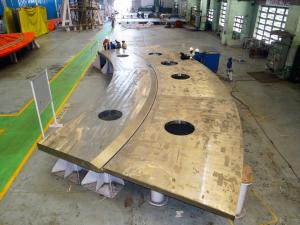Review gives green light to pursue cryostat manufacturing
26 Feb 2015
-
R.A.
"When you visit the Larsen & Toubro Ltd factory in Hazira, you can already see most of the cryostat segments at different stages of manufacturing," says Igor Sekachev, the engineer in charge of the cryostat at ITER. Pictured here, is one of the six 60° segments of the base section (tier-2).
Inaugurated last November, the 5,500-square-metre Cryostat Workshop will not remain empty for long. Later this year, in mid-September, the first batch of the 54 segments of the ITER cryostat (the huge vacuum chamber that insulates the superconducting magnets of the machine) will leave the Larsen & Toubro factory in Hazira, India, to be delivered to the ITER site for welding and assembly.
This first shipment will consist of the six 60-degree segments that form the first tier of the cryostat base section. The base section is one of four main sections (along with lower cylinder, upper cylinder and top lid) of the 30-metre-tall, 30 metre in diameter component. The cryostat base section—1,250 tonnes—is the single largest load of ITER Tokamak assembly. It will also be the first component to be installed in the Tokamak Pit when assembly begins.
In April 2013, a first Manufacturing Readiness Review was held for the base section and lower cylinder segments. It was complemented by a second review on 30 January this year for the remaining items, namely the upper cylinder, top lid, shielding blocks, assembly tooling, transporter frames, etc.
"A Manufacturing Readiness Review consists in a complete review of documents, from drawings to manufacturing guidelines, that ensures that every production step has been carefully observed," explains Igor Sekachev, the engineer in charge of the cryostat at ITER Organization, who participated in the review along with representatives of ITER India and contractor Larsen & Toubro.
Chaired by S.C. Chetal, former head of the Indira Gandhi Centre for Atomic Research (IGCAR), the panel also assessed the ongoing fabrication of the base section and lower cylinder at the shop floor.
"All in all, and as a result of the intense collaborative efforts between the ITER Organization, ITER India and Larsen & Toubro," adds Igor, "everything appears to be beautifully prepared and we gave our green light for the remainder of the manufacturing."
On-hold items are very few, principally interfacing components that haven't yet reached a sufficient level of maturity.
This is the case for the tokamak cooling water system, the large rectangular bellows, the circular bellows for the neutral beam injectors, and the housings for the torus cryopumps. "We're all working hard to bring these components to final design in order to release the on-hold items as soon as possible."
With Dilshad Sulaiman, ITER India
Chaired by S.C. Chetal, the review panel consisted of representatives from ITER India and ITER Organization, including: Igor Sekachev, Cryostat Section Leader at ITER; Anil Bhardwaj, Cryostat Project Manager at ITER India; M.K. Dipak, Expert from the Nuclear Power Corporation of India Ltd. (NPCIL); Girish Gupta, ITER India Cryostat Technical Responsible Officer; Rajnikant Prajapati, ITER India Cryostat Quality Assurance Responsible Officer; and Dilshad Sulaiman, ITER India Project Office & Communication Responsible Officer. Participants from Larsen & Toubro Ltd. were led by Ganesh Iyer (Cryostat Project Head) and Pandurang Jadhav (Cryostat Project Design Head).


